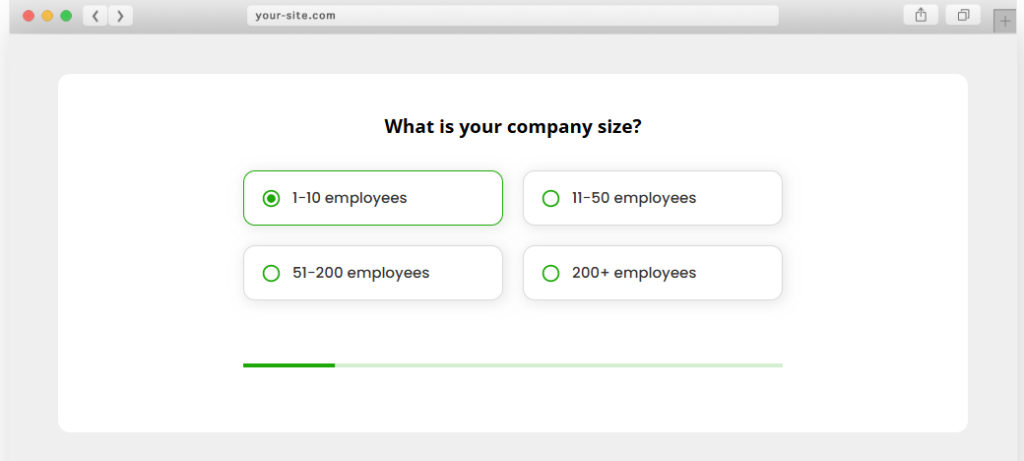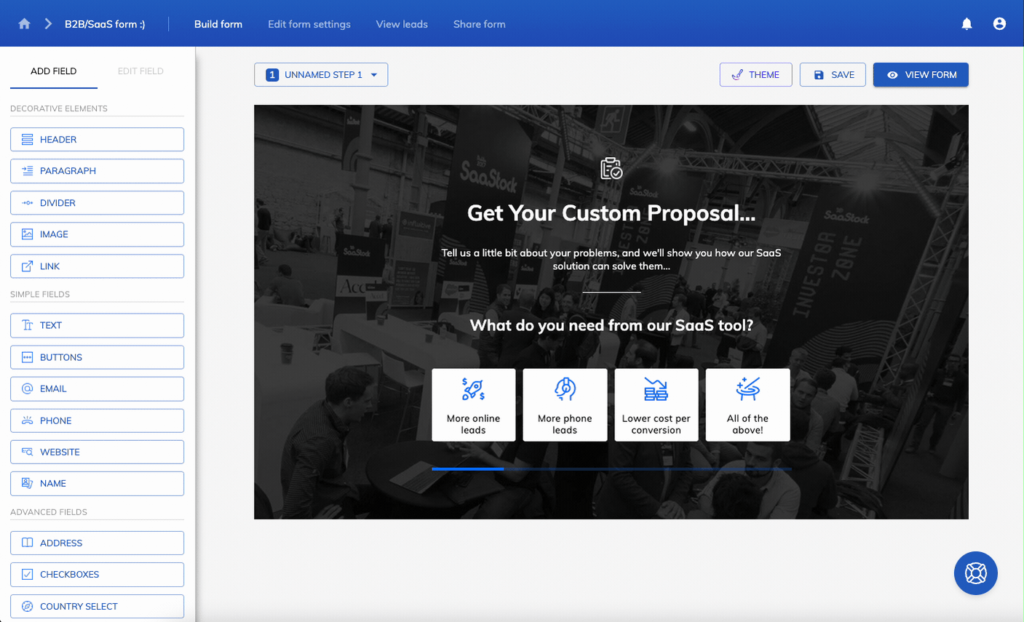Referral Forms
« Back to Glossary IndexQuick Summary
Referral forms make it easy for businesses to collect and track referrals from customers or employees. They simplify the process, ensuring your leads come from trusted sources while helping to boost conversion rates. In this article, we’ll dive into what referral forms are, why they’re so useful, and how to create one that gets people engaged. Plus, we’ll show you how tools like Growform can make the whole process smoother with customizable multi-step forms and seamless integrations. Check out our blog to learn more.
Want More Leads? Referral Forms Make It Easy
Word-of-mouth referrals convert at a 30% higher rate than other leads, making them one of the most powerful tools for growing your business. However, many companies struggle to track, manage, and encourage referrals effectively, leaving a valuable growth opportunity untapped. A well-designed referral form can be exactly what you need, streamlining the process and making it easy for customers and employees to submit high-quality referrals.
In this Growform guide, we’ll explore why referral forms are essential for your business, how they can boost your lead quality, and offer actionable tips on designing a form that drives real results.
Why Listen to Us?
At Growform, we help businesses capture and manage referrals effortlessly with multi-step forms, conditional logic, and CRM integrations. Referral forms work best when they’re easy to complete, intuitive, and integrated with existing workflows. Our solution ensures your forms are optimized for user experience and high conversion rates.

Businesses using Growform’s referral forms have seen higher engagement, increased lead quality, and a smoother referral process.
What Is a Referral Form?
A referral form is a structured document that allows individuals—customers, employees, or partners—to submit leads for a business. These forms help companies track and manage referrals efficiently while ensuring that leads are properly vetted.
Different Types of Referral Forms
- Customer Referral Forms: Customer referral forms are designed to encourage existing customers to refer friends, family, or colleagues in exchange for rewards, discounts, or incentives. Often paired with incentive programs like discounts or rewards for successful referrals, they help turn loyal customers into brand advocates. These forms typically include required fields for the referring customer’s details, the referred person’s contact information, and sometimes a personalized message.

- Employee Referral Forms: A great resource in hiring programs, these forms allow employees to recommend skilled candidates from their networks. This not only speeds up the recruitment process but also leads to better cultural fits within the company.
- Business Partnership Referral Forms: Business partnership referral forms help companies collect leads from affiliates, vendors, or partners. These forms are often used in B2B partnerships, where businesses refer clients to each other for commissions or mutual benefits.

With well-designed referral forms, businesses get better leads, and referrers have a smooth, hassle-free experience. Everybody wins!
Referral Forms vs. Standard Lead Forms
While both referral forms and standard lead capture forms collect information, they serve different purposes:
- Source of Leads: Referral forms gather recommendations from trusted sources, such as existing clients or partners, while standard lead forms collect direct inquiries from individuals who may have found you through ads, search engines, or other marketing efforts. Referral forms often leverage personal connections, providing a more targeted approach compared to the broader reach of standard lead forms.
- Trust Focus: Referred leads are typically more credible because they come with built-in trust from the person who referred them. This trust factor often leads to higher engagement and better conversion rates compared to cold leads generated through standard channels, where no prior relationship exists.
- Conversion Focus: Standard lead forms tend to attract a wider audience, which can include individuals at various stages of the buyer’s journey, from casual interest to exploratory research. On the other hand, referral forms bring in warmer prospects who often have a higher intent to engage, as they have already been vouched for and are more likely to align with your offerings.
By leveraging referral forms, you’ll be able to increase conversion rates while reducing acquisition costs.
Benefits of Using Referral Forms
Higher Lead Quality
Referral leads are more engaged and easier to convert because they come from trusted sources. Unlike cold leads, they skip the initial awareness stage, shortening the sales cycle. These referrals carry built-in trust, leading to stronger customer relationships and higher retention. When a lead comes from a friend, colleague, or partner, they’re already inclined to trust your product or service.
Lower Customer Acquisition Costs
Expensive ad campaigns aren’t the only way to generate leads. Referral programs offer a cost-effective alternative by leveraging word-of-mouth marketing. Instead of relying on paid ads, you can encourage customers to spread the word, bringing in high-quality leads at little to no cost. This creates a self-sustaining lead funnel, where happy customers or employees continuously refer new prospects, improving your long-term ROI. With less need for heavy ad spending, you can focus on strengthening relationships and improving your offerings.
Increased Customer & Employee Engagement
A good referral program does more than bring in leads—it builds loyalty and strengthens relationships. Rewarding customers for referrals keeps them engaged and turns them into advocates. Employees also benefit, feeling more connected to the company when recommending candidates. By offering incentives, you grow your business, boost customer satisfaction, and improve employee retention, creating a strong network of brand supporters.
How to Create an Effective Referral Form
1. Keep It Simple & User-Friendly
A referral form should be effortless to fill out—any unnecessary complexity can lead to drop-offs. Keep required fields to a minimum, asking only for essential details to streamline the process. Auto-fill features can make it even easier for repeat referrers to submit multiple referrals without re-entering the same information.
Since many users will access the form on mobile devices, ensuring mobile optimization is also key to maximizing participation and accessibility. The smoother the experience, the more referrals you’ll receive.
2. Offer Clear Incentives
People are more likely to refer friends or colleagues when there’s a clear benefit. Offering cash, discounts, or loyalty points gives users a reason to join your referral program. Tiered rewards, where users earn more for multiple referrals, can boost engagement.
Be transparent about how and when rewards are given—clear communication builds trust and keeps users referring.
3. Use Multi-Step Forms for Better Engagement
Long, overwhelming forms can discourage users from completing the process. Breaking the referral form into multi-step sections improves engagement by making it feel more manageable.
Start with Step 1: Basic referrer details, followed by Step 2: The referral’s contact information, and finally, Step 3: An explanation of the rewards and confirmation details.
This structured approach keeps users engaged and increases the likelihood of successful form submissions. Luckily, Growform makes it easy to build your own multi step form, with no developers required:

4. Automate Referral Tracking & Follow-Ups
Manually managing referrals can be time-consuming and inefficient. Automating the process ensures smooth tracking, faster follow-ups, and easier reward distribution.
Syncing your referral form with CRM systems allows you to track each referral’s progress in real time, while automated email confirmations keep referrers updated on their status. Automating reward distribution also reduces administrative workload and ensures participants receive their incentives on time, keeping them motivated to refer more.
5. Promote the Referral Form Effectively
Even the most well-designed referral form won’t generate results if people don’t know about it. Make it highly visible by embedding it on your website, thank-you pages, and email campaigns.
Use social media promotions to encourage sharing and reach a wider audience. You can also include referral links in invoices, newsletters, or order confirmations, making it easy for customers to participate. The more exposure your form gets, the more referrals you’ll receive.
Capture More Referrals with Growform
Referral forms are one of the most effective ways to generate high-quality leads while lowering acquisition costs. With the right design and automation, businesses can turn satisfied customers into powerful brand advocates.
Growform simplifies referral programs with multi-step forms, seamless CRM integrations, and automated tracking, making it easier than ever to manage and optimize your referral process.Start generating more high-quality referrals with Growform today!
Recent Posts
- Your Guide to Using Webflow Form Builder Effectively
- Top 5 Lead Capture Form Examples That Can Boost Your Conversions (2025)
- What Is an Elementor Multi-Step Form & How Does Growform Improve It?
- We Review The Best Microsoft Forms Alternatives for Better Customization and Control
- Here’s Our Review of the Best Form Builders For WordPress Sites
